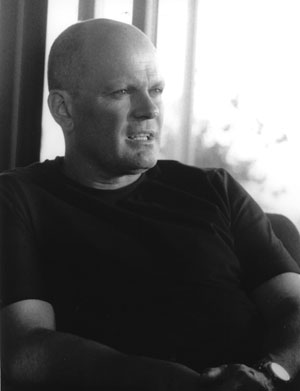A conference organized by Brian MacKay-Lyons aims to push locavore design to the forefront.
| Photo © Manuel Schnell |
In lieu of his annual "Ghost Lab" design-build workshops, MacKay-Lyons will host a summer conference at his Nova Scotia farm. |
In the summer of 1994, Nova Scotia architect Brian MacKay-Lyons and a teaching colleague, Richard Kroeker, took their students at Dalhousie University in Halifax to MacKay-Lyons’s farm and taught them how to actually build a structure with their own hands. It was the first “Ghost Lab,” so named because the land’s rocky ruins mark the ghost of a village, a European settlement from more than 400 years ago.

Ghost 13: Ideas In Things Conference
When: June 14-17
Where: MacKay-Lyons Farm, Nova Scotia
Cost: $2,500 per person; Attendance limited
To register: http://www.mlsarchitects.ca/ghost/apply/
Keynote Speakers
Kenneth Frampton, New York
Juhani Pallasmaa, Finland
Speakers
Deborah Berke, New York
Marlon Blackwell, Arkansas
Wendell Burnette, Arizona
Ted Flato, San Antonio
Andrew Freear, Alabama
Vincent James, Minnesota
Rick Joy, Arizona
Francis Kéré, Berlin and Burkina Faso
Richard Kroeker, Nova Scotia
Tom Kundig, Seattle
Brian MacKay-Lyons, Nova Scotia
Patricia Patkau, Vancouver
Dan Rockhill, Kansas
Brigitte Shim, Toronto
Peter Stutchbury, Sydney
Critics
Peter Buchanan, London
Tom Fisher, Minnesota
Robert McCarter, St. Louis
Moderators
Essy Baniassad, Hong Kong
Robert Ivy, Washigton, D.C.
Christine Macy, Nova Scotia
Since then, as MacKay-Lyons has gained an international following for his “plain modern” architecture, his hands-on Ghost Lab has grown into a kind of elite and magical summer camp. Architects and critics from as far away as Australia have made the pilgrimage to the roughly 60-acre farm, spectacularly sited along the rugged Nova Scotia coast, where they join two dozen students who collectively design and construct a building using the vernacular materials and techniques of the local barns, boats, and fishing huts. The idea isn’t to ape the past but to embrace the venerable notion of the master builder, along with the ethics of good craftsmanship and sensitivity to the land and the community.
Now Ghost Lab is opening up to a larger audience, though anyone who’d like to attend this summer can leave his or her tool belt at home. From June 14-17, MacKay-Lyons will host a conference instead, for 200 people, to explore the ideas that have emerged from the design-build workshops and from his architectural practice. “The conference is about the same themes as Ghost Lab—the connection to place, to craft, to community,” said MacKay-Lyons, speaking on the phone from his farm, an-hour-and-quarter drive from Halifax. (Outside, he said, he could see sheep grazing on the windswept hill.) While the first and simplest Ghost Lab structures were temporary, those designed and built since 2005 have become part of the farm’s infrastructure, including four cedar-shingled cottages, a 90-foot-long studio clad in corrugated metal, and a reconstructed 1880s octagonal barn, where much of the conference will take place.
For MacKay-Lyons and the like-minded architects who’ve become his colleagues and friends, the conference, called “Ideas in Things,” was a natural evolution from Ghost Lab. “We always talked about having this,” said MacKay-Lyons. “There’s a clubhouse effect of having the site, where every year people congregate.” The idea took firm hold three years ago while the architect was on a trip with four of his Ghost Lab buddies to see the ancient Dogon dwellings in Mali, Africa. That posse of North American architects—Rick Joy and Wendell Burnette (both from Arizona), Tom Kundig (Seattle), and Marlon Blackwell (Arkansas)—will speak at the conference, along with Deborah Berke (New York), Ted Flato (San Antonio), Patricia Patkau (Vancouver) and Francis Kéré (Berlin and Burkina Faso), among others. Critics will also participate, including Kenneth Frampton, Juhani Pallasmaa, and Peter Buchanan. Pritzker-Prize winner Glenn Murcutt, whom MacKay-Lyons calls “the James Brown of this movement,” may turn up, too.
And make no mistake: MacKay-Lyons and his cohorts do see this as a movement—or as Buchanan puts it, “the resistance”—to counter the numbing effects of globalization and a design culture that seems to favor theory over craft and spectacle over place. A part of the group’s mission is to take on architectural education, which, said MacKay-Lyons, has “become flakier and flakier, and less about making things.” In contract, he credits the Rural Studio at Auburn University in Alabama, or the work of Dan Rockhill at the University of Kansas, whose students design and build affordable pre-fab housing. Both Rockhill and Rural Studio director Andrew Freear will speak at the Ghost conference.
Like the organic food movement, the ideals of this “locavore” architecture may seem a bit romantic on a planet where 50 percent of the population now live in cities, many in deplorable conditions. But Mackay-Lyons believes the Ghost group’s ideas could have a meaningful impact. “I know we’re from wealthy industrialized countries,” he said, “but we’re all committed to the idea of making architecture out of local materials and local labor and making it affordable.” (The handsome Canadian embassy in Bangladesh that his firm recently finished used what that impoverished country had in abundance: bricks and bricklayers.)
But can a small summer conference like Ghost, tucked up in Nova Scotia, really make waves? “We’re all operating on the periphery of the fashion discourse,” MacKay-Lyons freely admitted. “We’re all boonies architects. But I think when we come together as a group, there is a strength in numbers.” The conference will generate a book and possibly a film. And doubtless there are many practitioners around the globe who share their convictions and concerns. So the goal of the conference isn’t small. “We hope,” said MacKay-Lyons, “to change the conversation in architecture.”











Post a comment to this article
Report Abusive Comment